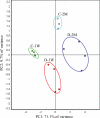Molecular targets for diabetes mellitus-associated erectile dysfunction
- PMID: 20007950
- PMCID: PMC2849705
- DOI: 10.1074/mcp.M900286-MCP200
Molecular targets for diabetes mellitus-associated erectile dysfunction
Abstract
Protein expression profiles in rat corporal smooth muscle tissue were compared between animal models of streptozotocin-induced diabetes mellitus (STZ-DM) and age-matched controls (AMCs) at 1 week and 2 months after induction of hyperglycemia with STZ treatment. At each time point, protein samples from four STZ-DM and four AMC rat corpora tissues were prepared independently and analyzed together across multiple quantitative two-dimensional gels using a pooled internal standard sample to quantify expression changes with statistical confidence. A total of 170 spots were differential expressed among the four experimental groups. A subsequent mass spectrometry analysis of the 170 spots identified a total of 57 unique proteins. Network analysis of these proteins using MetaCore suggested altered activity of transcriptional factors that are of too low abundance to be detected by the two-dimensional gel method. The proteins that were down-regulated with diabetes include isoforms of collagen that are precursors to fibril-forming collagen type 1; Hsp47, which assists and mediates the proper folding of procollagen; and several proteins whose abundance is controlled by sex hormones (e.g. CRP1 and A2U). On the other hand, proteins seen or predicted to be up-regulated include proteins involved in cell apoptosis (e.g. p53, 14-3-3-gamma, Serpinf1, Cct4, Cct5, and Sepina3n), proteins that neutralize the biological activity of nerve growth factor (e.g. anti-NGF 30), and proteins involved in lipid metabolism (e.g. apoA-I and apoA-IV). Subsequent Western blot validation analysis of p53, 14-3-3-gamma, and Hsp47 confirmed increased p53 and 14-3-3-gamma and decreased Hsp47 levels in separate samples. According to the results from the Western blot analysis, Hsp47 protein showed a approximately 3-fold decrease at 1 week and was virtually undetectable at 2 months in diabetic versus control. Taken together, our results identify novel candidate proteins playing a role in erectile dysfunction in diabetes resulting from STZ treatment.
Figures






Similar articles
-
Proteomics analysis identifies molecular targets related to diabetes mellitus-associated bladder dysfunction.Mol Cell Proteomics. 2008 Jul;7(7):1270-85. doi: 10.1074/mcp.M700563-MCP200. Epub 2008 Mar 12. Mol Cell Proteomics. 2008. PMID: 18337374 Free PMC article.
-
Effects of icariside II on improving erectile function in rats with streptozotocin-induced diabetes.J Androl. 2012 Sep-Oct;33(5):832-44. doi: 10.2164/jandrol.111.015172. Epub 2012 Mar 8. J Androl. 2012. PMID: 22403279
-
Effects of ageing and streptozotocin-induced diabetes on connexin43 and P2 purinoceptor expression in the rat corpora cavernosa and urinary bladder.BJU Int. 2009 Jun;103(12):1686-93. doi: 10.1111/j.1464-410X.2008.08337.x. Epub 2009 Jan 14. BJU Int. 2009. PMID: 19154470 Free PMC article.
-
Functional and morphologic characterizations of the diabetic mouse corpus cavernosum: comparison of a multiple low-dose and a single high-dose streptozotocin protocols.J Sex Med. 2009 Dec;6(12):3289-304. doi: 10.1111/j.1743-6109.2009.01464.x. Epub 2009 Sep 1. J Sex Med. 2009. PMID: 19732306
-
Effects of icariin on improving erectile function in streptozotocin-induced diabetic rats.J Sex Med. 2011 Oct;8(10):2761-72. doi: 10.1111/j.1743-6109.2011.02421.x. J Sex Med. 2011. PMID: 21967314
Cited by
-
Acetyl-L-carnitine increases mitochondrial protein acetylation in the aged rat heart.Mech Ageing Dev. 2015 Jan;145:39-50. doi: 10.1016/j.mad.2015.01.003. Epub 2015 Feb 7. Mech Ageing Dev. 2015. PMID: 25660059 Free PMC article.
-
Metabolomics coupled with proteomics advancing drug discovery toward more agile development of targeted combination therapies.Mol Cell Proteomics. 2013 May;12(5):1226-38. doi: 10.1074/mcp.M112.021683. Epub 2013 Jan 29. Mol Cell Proteomics. 2013. PMID: 23362329 Free PMC article.
-
14-3-3 protein regulation of excitation-contraction coupling.Pflugers Arch. 2022 Mar;474(3):267-279. doi: 10.1007/s00424-021-02635-x. Epub 2021 Nov 25. Pflugers Arch. 2022. PMID: 34820713 Free PMC article. Review.
-
Relationship between gut microbiota and type 2 diabetic erectile dysfunction in Sprague-Dawley rats.J Huazhong Univ Sci Technolog Med Sci. 2017 Aug;37(4):523-530. doi: 10.1007/s11596-017-1767-z. Epub 2017 Aug 8. J Huazhong Univ Sci Technolog Med Sci. 2017. PMID: 28786059
-
The Medicinal Plant Pair Bupleurum chinense-Scutellaria baicalensis - Metabolomics and Metallomics Analysis in a Model for Alcoholic Liver Injury.Front Pharmacol. 2019 Mar 20;10:254. doi: 10.3389/fphar.2019.00254. eCollection 2019. Front Pharmacol. 2019. PMID: 30971921 Free PMC article.
References
-
- Burchardt T., Burchardt M., Karden J., Buttyan R., Shabsigh A., de la Taille A., Ng P. Y., Anastasiadis A. G., Shabsigh R. (2000) Reduction of endothelial and smooth muscle density in the corpora cavernosa of the streptozotocin induced diabetic rat. J. Urol 164, 1807–1811 - PubMed
-
- Shabsigh R., Klein L. T., Seidman S., Kaplan S. A., Lehrhoff B. J., Ritter J. S. (1998) Increased incidence of depressive symptoms in men with erectile dysfunction. Urology 52, 848–852 - PubMed
-
- Lue T. F. (2000) Erectile dysfunction. New Engl. J. Med 342, 1802–1813 - PubMed
-
- Feldman H. A., Goldstein I., Hatzichristou D. G., Krane R. J., McKinlay J. B. (1994) Impotence and its medical and psychosocial correlates: results of the Massachusetts Male Aging Study. J. Urol 151, 54–61 - PubMed
-
- Rosen R. C., Fisher W. A., Eardley I., Niederberger C., Nadel A., Sand M. (2004) The multinational Men's Attitudes to Life Events and Sexuality (MALES) study: I. Prevalence of erectile dysfunction and related health concerns in the general population. Curr. Med. Res. Opin 20, 607–617 - PubMed
Publication types
MeSH terms
Substances
Grants and funding
LinkOut - more resources
Full Text Sources
Medical
Research Materials
Miscellaneous

